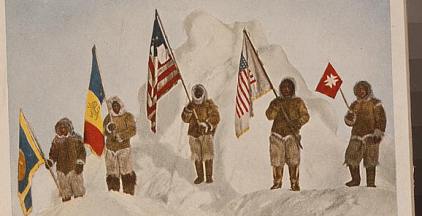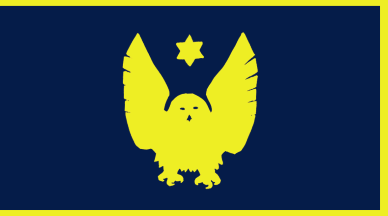
This page is part of © FOTW Flags Of The World website
Famous Flags: Flags Raised in Exploration
Last modified: 2019-01-09 by rob raeside
Keywords: everest | peary | north pole |
Links: FOTW homepage |
search |
disclaimer and copyright |
write us |
mirrors
See also:
Flags at the North Pole

Source: Library
of Congress American Memory Collection
According to a letter of 9 December 1909 from Peary to Edward Trenchard of the U.S. Navy League, "The flags displayed at the Pole
were displayed on poles consisting of a tent pole and the shafts of
the ice lances, one of which was carried on each sledge.
The five flags are, from left to right in the photograph:
- Navy League of the United States: Held by the Inuit Ooqueah. The
flag, according to Peary's letter to Trenchard cited above, was
provided by the ladies of the League. Since Annin & Co., the large
New York flag company, is known to have provided flags for the Peary
expedition, I have followed Annin's 1914 wholesale catalogue for the
design of this flag: white with a yellow border and the Navy League
emblem on the center--a blue disk with a yellow anchor surrounded by
the white letters U, S, N, and L. However, I should note that the
flag in the Peary black and white photos is a light shade of gray,
and that the hand-colored version of the photograph that was prepared
in 1910 for Peary's The North Pole: Its Discovery shows the flag as
light blue with a yellow border and a copper-colored disk.
- Delta Kappa Epsilon: Held by the Inuit Ootah; the flag of Peary's
fraternity as an undergraduate at Bowdoin College in Maine. It is a
vertical tricolor of light blue, yellow, and red with a lion rampant
on the center stripe, although the
rendering of the lion may have been somewhat different. This flag
also appears in the Annin catalogue. After his return, Peary was
feted at a dinner given by the DKE Club of New York and displayed
this flag there.
- United States: Held by Peary's long-time assistant and comrade,
Matthew Henson. Peary wrote of this flag, "We planted five flags at
the top of the world. The first one was a silk American flag which
Mrs. Peary gave me fifteen years ago. That flag has done more
traveling in high latitudes than any other ever made. I carried it
wrapped about my body on every one of my expeditions northward after
it came into my possession, and I left a fragment of it at each of my
successive 'farthest norths'.... By the time it actually reached the
Pole, it was somewhat worn and discolored. A broad diagonal section
of this ensign would now mark the farthest goal of earth--the place
where I and my dusky companions stood.... In a space between the ice
blocks of a pressure ridge, I deposited a glass bottle containing a
diagonal strip of my flag and records." An off-white diagonal band
was sewn in place of the section Peary left at the Pole. A sketch of this flag
can be viewed here.
The U.S. flag with the diagonal band seemed to have been something of
an obsession with Peary; a couple of sketches of this flag appear in
is notebooks (at the National Archives,
one dated April 7, the day after reaching the pole with the note "Flag with diagonal white bar to be
my personal flag."
Other entries refer to using the design on his letterhead, seal, and
as a trademark to authenticate "all N.P. [North Pole] articles." A
reproduction of this flag was made by Mrs. Peary for the explorer to
display on the lecture circuit and is now in the collection of the
Maine State Museum, complete with the patches on the areas where the
various fragments were removed from the original; see
State
of Maine Archives).
- Peace Flag: Held by the Inuit Egingwah. Often described as the flag
of the Daughters of the American Revolution, or as the DAR peace
flag, Peary refers to it as the "'World's Ensign of Liberty and
Peace,' with its red, white and blue in a field of white." The
photograph bears out that it is not the DAR flag (a vertical triband
of light blue, white, and light blue with the society insignia on the
center). Since the design of the flag had nothing to do with the DAR,
it was presumably provided to Peary by the society, since Peary's
notes for March 28 do refer to a "D.A.R. flag," and he wrote after
the expedition to the DAR discussing a flag he had displayed for them
at the pole. Again, on the assumption that the flag was produced by
Annin & Co., I've followed the pattern in their catalogue (granted
that it was issued five years later), which includes the inscription
in gold Old English lettering "Peace among all Nations" across the
upper part of the white border. I've been unable to find a photograph
of Peary's flag that is clear enough to tell for certain whether such
lettering was present; it may well not have been. A circa US peace
flag circa 1891, without the writing, by Rick Wyatt, is already on
FOTW.
- "Red Cross" Flag: Held by the Inuit Seeglo. This one is a mystery.
It is invariably referred to by Peary as a Red Cross flag, yet it
clearly appears in the photographs as a dark field with a white (or
very light) Maltese cross. The hand-colored photo in Peary's book
shows it red with a white cross, apparently the same as the modern
Maltese civil ensign. It is much smaller than the other flags present
at the Pole. I had thought that perhaps the American Red Cross at the
time used a flag other than the familiar Geneva Convention flag, but
a look at an on-line
exhibition of Red Cross flags indicates not.
Joe McMillan, 13 July 2008, citing a 2 January 2004 post
First ascent of Everest
New Zealand's most famous flag photo is probably of the
planting of the flags of (from memory) China,
India, Nepal, and
Britain's flags on top of Mt. Everest by Sir Edmund Hillary in 1953.
James Dignan, 02 August 1996
Hillary and Tensing's Flag on Mount Everest undoubtedly blew away in the wind!
James Dignan, 11 December 1997
Edmund Hillary (in a striking contrast to many subsequent climbers) did not choose
to place himself and his country's flag on the top of the world in the photograph.
The flags, held by Sherpa Tenzing Norgay, were (top to bottom) the
United Nations, UK,
Nepal, India.
Per Kolmodin, 05 October 1999
See also:
 image by Olivier Touzeau, 25 December 2018
image by Olivier Touzeau, 25 December 2018
Count Guido Monzino (born 2 March 1928 in Milan, Italy – died 11 October 1988)
was an Italian mountain climber and explorer. He was the son of Franco Monzino
who founded the Italian supermarket chain Standa.
He made a total of 21
expeditions to places including Patagonia, Equatorial Africa, Greenland, the
North Pole and the Himalaya. He led in 1973 the first Italian expedition to
climb Mount Everest. In 1974 he bought the famous Villa del Balbianello on the
banks of Lake Como. He willed Villa del Balbianello to the Fondo per l'Ambiente
Italiano and he was buried there.
NB : The villa was also used for the lake
retreat scenes in Star Wars: Episode II Attack of the Clones (2002).
The
villa contains a museum devoted to Monzino which includes his collections of
maps and books and many artefacts and memorabilia from his expeditions,
including the flags of his expeditions to the North Pole in 1971 and to Mount
Everest in 1973.
- Expedition to Mount Everest : a Nepalese flag
-
Expedition to North Pole : flags from the neighbouring countries (Canada, USSR,
USA, Norway, and Denmark for Greenland) and a strange flag presented in the
Museum as the flag of the North Pole : blue with a thin yellow border on three
sides, and with a yellow snowy owl (Bubo scandiacus) and six-pointed
yellow star.
See pictures of this flag in use at:
http://www.mondieviaggi.eu/storie/viaggiatori/guido-monzino-un-conte-al-polo-nord/
https://milano.corriere.it/foto-gallery/cronaca/16_maggio_12/spedizione-italiana-guido-monzino-polo-nord-33adfcf8-1883-11e6-a192-aa62c89d5ec1.shtml
http://magazine.viaggipolari.it/guido-monzino-il-tricolore-sventola-al-polo-nord/
Olivier Touzeau, 25 December 2018
 image by Olivier Touzeau, 25 December 2018
image by Olivier Touzeau, 25 December 2018

 image by Olivier Touzeau, 25 December 2018
image by Olivier Touzeau, 25 December 2018